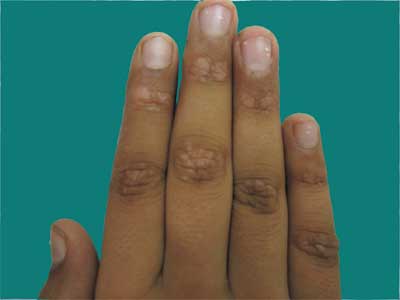A 12-year old boy, presented with skin colored raised lesions on dorsum
of his hands for 2 years. There were multiple, 1 to 4-mm, skin-colored,
firm, discrete, smooth surfaced papules, present on the dorsal aspect of
both hands. Skin biopsy revealed hyperkeratosis, hypergranulosis,
acanthosis and a normal dermis. Elastin stain did not reveal any
degeneration. The child was diagnosed with focal acral hyperkeratosis.
The differential diagnosis include verruca vulgaris,
acrokeratoelastoidosis of Costa, degenerative collagenous plaques of the
hands, keratoelastoidosis marginalis of the hands, punctate palmoplantar
keratoderma, digital papular calcinosis, acral mucinosis, acrokeratosis
verruciformis of Hopf and xanthoma. The skin lesions in hereditary
papulotranslucent acrokeratoderma are characteristically exacerbated
after exposure to water. Marginal papular acrokeratoderma encompasses a
group of disorders that share crateriform, keratotic papules along the
margins of the hands and feet. Warts exhibit verrucous surface as
compared to smooth papules of focal acral hyperkeratosis. Punctate
palmoplantar keratoderma is associated with thickened palms and soles,
acral mucionosis and xanthoma have a shiny white coloured appearance.
Probably a biopsy with special staining (presence of elastorrhexis,
mucin, fat, calcium deposits) would aid in their definite
differentiation.
 |
|
Fig.1 Multiple skin -colored papules.
|
Although the condition is benign, it may cause
psychological and cosmetic concern to the patient. Multiple therapies
have been attempted like topical keratolytics (urea, salicylic acid, and
lactic acid), topical retinoids (tazarotene) and systemic agents like
acitretin. Recurrences are reported on discontinuation.

